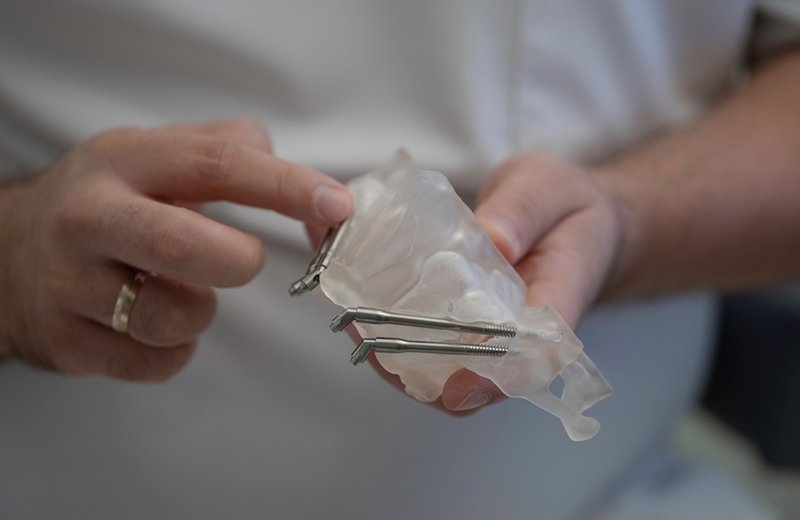Dental implants are the most advanced and durable solution for replacing one or more missing teeth. They are placed into the jawbone to serve as long-term anchors for crowns or bridges, restoring both function and aesthetics while preserving the underlying bone.
Why It Matters
When a tooth is lost, the surrounding bone begins to shrink. Implants prevent that bone loss, keep your bite stable, and look and feel like natural teeth. Unlike bridges, implants don’t rely on neighboring teeth for support.

Zirconia Implants
In addition to traditional titanium implants, we also offer zirconia implants—a ceramic, metal-free alternative ideal for patients with sensitivities or those seeking a more aesthetic or holistic approach. Zirconia is biocompatible, white in color, and excellent for front-tooth areas or those with concerns about metal exposure.

How the Process Works
- Consultation & 3D Imaging: We use high-resolution scans to evaluate your bone and plan the exact placement.
- Surgical Placement: Performed under local anesthesia or optional sedation, based on your comfort level.
- Healing Phase: The implant integrates with your bone over 3–6 months.
- Restoration: Your general dentist places the final crown or bridge.
Recovery
Most patients experience mild swelling or discomfort for a few days. You’ll return to normal activities quickly, and we follow up closely to ensure smooth healing.
All-on-x
Why Choose All-on-X?
- Immediate function with same-day temporary teeth in many cases
- No need for removable dentures
- Improved bite strength, comfort, and appearance
- Preserves jawbone structure and facial aesthetics
- Faster overall treatment timeline compared to traditional implants.


Who It’s For
- All-on-X is ideal for patients who:
- Are missing all or most of their teeth
- Have loose or failing bridges/dentures
- Want a fixed, non-removable solution
- May have limited bone volume but still want to avoid bone grafting
How the Process Works
Planning:
High-resolution 3D imaging is used to plan the ideal implant positions and prosthetic fit.
Surgery:
On the day of surgery, we place 4–6 implants and attach a temporary set of fixed teeth (in most cases).
Healing:
Over 3–6 months, the implants integrate with the bone while you wear the temporaries.
Final Teeth:
Your general dentist will design and deliver the final, permanent prosthetic once healing is complete.
Recovery
Most patients return to light activity within 48–72 hours. Swelling and discomfort are expected but manageable. We provide detailed recovery instructions and monitor your healing closely.
Zygomatic Implants
Zygomatic implants are a specialized type of dental implant used in the upper jaw when there is severe bone loss. Instead of anchoring into the jawbone like traditional implants, they are placed into the zygomatic bone (cheekbone)—which provides strong, stable support without the need for bone grafting.
Who Needs Zygomatic Implants?
- Have been told they don’t have enough bone for implants
- Have worn dentures for many years
- Want to avoid sinus lifts or bone grafting procedures
- Are looking for a fixed, long-term alternative to removable dentures

Why Choose Zygomatic Implants at SFIOS?
This is a highly specialized procedure that requires advanced surgical skill and 3D planning technology. At SFIOS, we are equipped with the expertise and technology to safely perform zygomatic implant placement in even the most complex cases.

Benefits include:
- Avoiding extensive grafting surgeries
- Faster treatment timeline
- Immediate or early loading in select cases
- High success rates even in compromised bone
How the Process Works
Planning:
We use 3D imaging and virtual surgery software to precisely plan implant placement.
Surgery:
Performed under sedation or general anesthesia. Zygomatic implants may be combined with traditional implants if needed.
Restoration:
A fixed provisional set of teeth may be delivered the same day or shortly after, depending on your case.
Recovery
Recovery is similar to that of traditional full-arch implant surgery. Most patients experience swelling and mild discomfort for a few days. We provide detailed post-op instructions and closely monitor healing.
